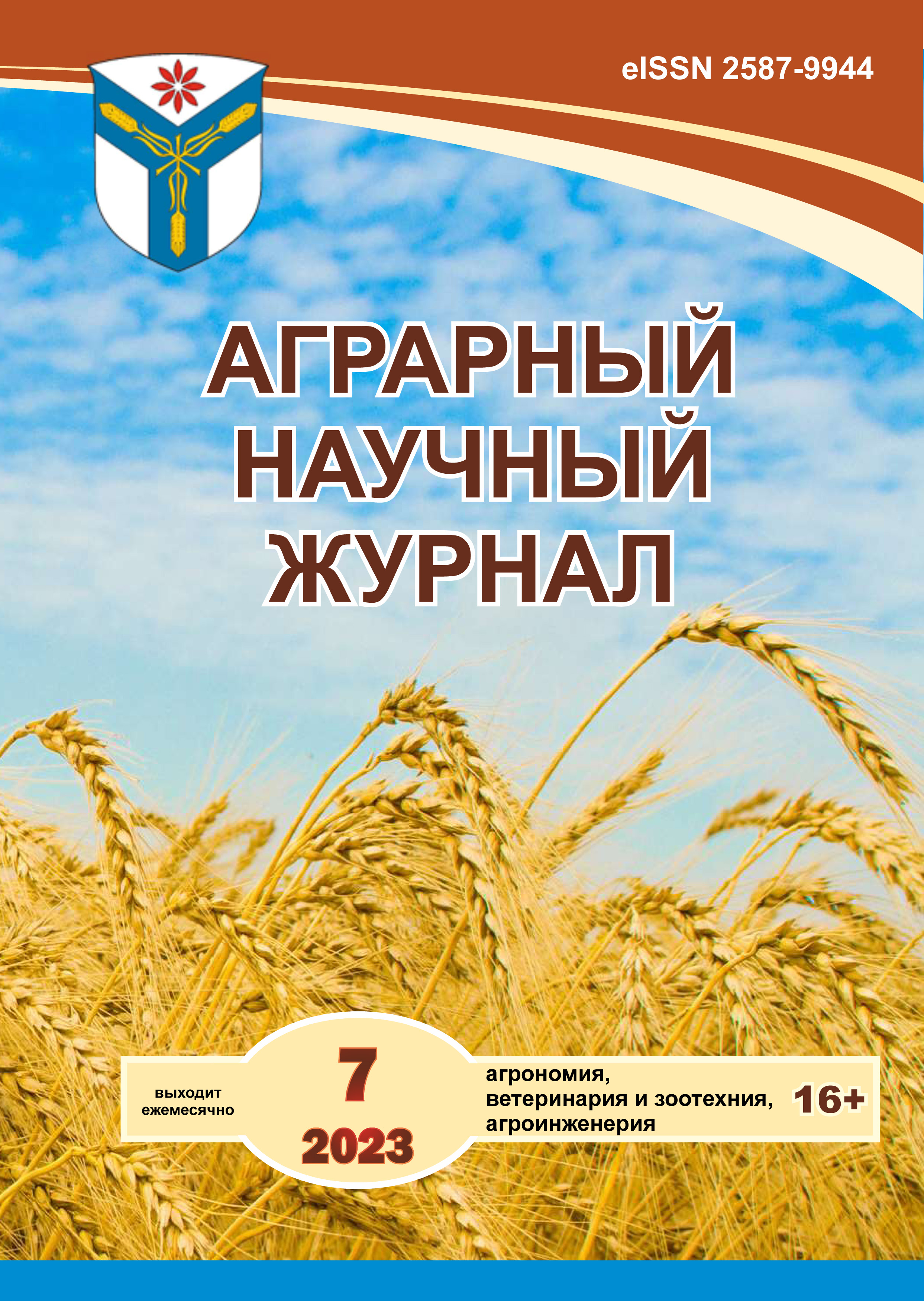Economically valuable characteristics and breeding indices of spring barley varieties of different ecological and geographical origin in the conditions of the Ryazan region
DOI:
https://doi.org/10.28983/asj.y2023i7pp22-28Keywords:
barley (Hordeum vulgare L.), variety, productivity, crop structure, breeding indicesAbstract
The article presents the results of research conducted in the collection nursery of spring barley in the conditions in 2020–2022. The purpose of the research is to identify economically valuable traits and calculate breeding indices of selected sources of spring barley of different ecological and geographical origin in the conditions of the forest–steppe zone of the Ryazan region for inclusion in the hybridization program. It was revealed that the varieties Reliable (RF) and Dzivosny (Belarus) had the highest productivity in the conditions of the region with an average yield of 6.48 and 6.40 t/ha, respectively. It was found that the shortest straw had the German varieties KVS Vermont and Ellinor, whose height is in the range of 63-67 cm and varies little over the years of research (CV, % = 3.9 ...6.0). According to the length of the ear, the varieties Bente (Germany) (8.2 cm), Jaromir and Noble (8.0 cm) (RF) stood out. It was revealed that the maximum number of grains in the ear is formed by the Yaromir and Noble varieties – 23.7 pcs. and 23.4 pcs., respectively. According to grain size, the varieties Kufal, Raider (Belarus) and Bente were distinguished, having a mass of 1000 grains of more than 50.0 g. When calculating the breeding indices, it was found that the productivity of domestic varieties was influenced by the Canadian Ki index (r= +0.829) and the harvest index of KHOZ, % (r= +0.559), the Belarusian varieties of the IPPR plant productivity index (r= +0.478), German varieties Ki (r= +0.747) and the linear density index ear of LPC (r = +0.604). On average, according to the number of selected indices, the Noble and Dzivosny varieties come out on top – the maximum indicators for three indices, Yaromir (RF), Ataman (Belarus), KVS Harris, KVS Vermont, Beatrice (Germany) – in second place – for two indices. The varieties of spring barley distinguished by the individual studied positive signs and their complex are recommended for use in breeding programs.
Downloads
References
Влияние агрометеорологических изменений климата на зерновую продуктивность ярового ячменя в условиях Нечерноземной зоны РФ / О. В. Левакова [и др.] // Юг России: экология, развитие. 2022. Т.17. № 1. C. 128–135.
Доспехов Б. А. Методика полевого опыта (с основами статистической обработки результатов исследований). М., 2012. 352 с.
Левакова О. В., Ерошенко Л. М. Новый сорт ярового ячменя Знатный // Аграрная наука. 2020. № 9. С. 80–83.
Левакова О. В. Вариабельность элементов структуры урожая ярового ячменя в зависимости от гидротермических условий вегетации // Аграрная наука Евро-Северо-Востока. 2022. № 23(3). С. 327–333.
Максимов Р. А. Изучение сортообразцов ячменя мировой коллекции ВИР в условиях Среднего Урала // АПК России. 2015. Т. 74. С. 141–144.
Малокостова Е. И., Пивоварова И. Ю., Попова А. В. Оценка селекционных линий и сортов яровой пшеницы по селекционным индексам // Вестник Мичуринского государственного аграрного университета. 2019. № 1. С. 24–28.
Манукян И. Р., Басиева М. А., Мирошникова Е. С. Использование селекционных индексов в комплексной оценке озимой пшеницы на продуктивность // Международный академический вестник. 2019. № 7(39). С. 41–44.
Методика государственного сортоиспытания сельскохозяйственных культур / под ред. В. И. Головачева, Е. В. Кириловской. М., 2019. 194 с.
Новохатин В. В. Эффективность различных методов отбора в селекции яровой пшеницы // Достижения науки и техники в АПК. 2016. № 3. С. 42–45.
Ресурсы отрасли: обзор российского зернового комплекса [Электронный ресурс]. Режим доступа: https://www.agbz.ru/articles/resursy-otrasli-obzor-rossiyskogo-zernovogo-kompleksa/ (дата обращения: 28.11.2022).
Современное состояние и пути повышения конкурентоспособности отечественной селекции и семеноводства / Л. А. Беспалова [и др.] // Труды Кубанского государственного аграрного университета. 2015. № 3(54). C. 99–102.
Сурин Н. А., Ляхова Н. Е., Герасимов С. А., Липшин А. Г. Интегрированная оценка адаптивной способности образцов ячменя из коллекции ВИР в условиях Красноярской лесостепи // Достижения науки и техники АПК. 2016. Т. 30. № 6. С. 32–35.
Bome N. A., Tetyannikov N. V., BomeA.Ya., Kovaleva O. N. Ecological and Biological Studies of Collection of the Genus Hordeum L. // Temperate Crop Science and Breeding. Ecological and Genetic Studies: Apple Academic Press. 2016. P. 305–322.
The elements of productivity and their contribution to high level of crop yield / L. M. Eroshenko et al. // IOP Conf. Series: Earth and Environmental Science. 2021;843: 012005.
Downloads
Published
Issue
Section
License
Copyright (c) 2023 The Agrarian Scientific Journal

This work is licensed under a Creative Commons Attribution-NonCommercial-NoDerivatives 4.0 International License.








